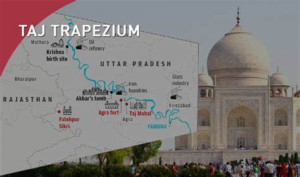In News: The Supreme court of India lifted its earlier interim order imposing a complete ban on construction, industrial activities and felling of trees in the Taj Trapezium Zone (TTZ).
What is Taj Trapezium Zone ?

- It is a defined area of 10,400 sq km around the Taj Mahal to protect the monument from pollution.
- The Supreme Court of India delivered a ruling on December 30, 1996, regarding industries covered under the TTZ, in response to a PIL seeking to protect the Taj Mahal from environmental pollution.
- It banned the use of coal/ coke in industries located in the TTZ with a mandate for switching over from coal/ coke to natural gas, and relocating them outside the TTZ or shutting down.
- The TTZ comprises monuments including three World Heritage Sites, the Taj Mahal, Agra Fort and Fatehpur Sikri.
- TTZ is so named since it is located around the Taj Mahal and is shaped like a trapezoid.
- It has a four-zone which is named Red, Green, Orange and White.
Geographical location
- The geographical limits of the Taj Trapezium Zone is defined in the shape of a trapezium lying in the Agra Division of the State of Uttar Pradesh and in the Bharatpur Division of the State of Rajasthan.
SC Proceeding on Taj preservation
- Petitions for the conservation of Taj have been hovering the corridors of Supreme Court for over 3 decades now.
- In a 1996 case, the SC ordered a slew of measures, including the closure of factories in the vicinity, to protect the monument.
- Supreme Court Ruling: In response to a Public Interest Litigation seeking to protect the Taj Mahal from environmental pollution, the Supreme Court of India delivered a ruling in December,1996 that banned the use of coal/ coke in industries located in the TTZ.
- It ordered for switching over from coal/ coke to natural gas, and relocating them outside the TTZ or shutting down.
- But successive governments haven’t implemented these in spirit, which has resulted in the monument turning from “Whitish to yellowish” and then to the current state of brownish-green.
- Recently, the SC criticised “Archaeological Survey of India” for its dismal performance in preserving the monument.
- The Central Government in exercise of the powers conferred under the Environment (Protection) Act, 1986 has constituted the Taj Trapezium Zone Pollution (Prevention and Control) authority in 1998.
















